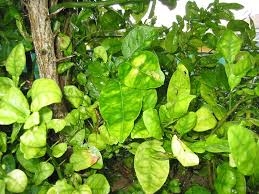Citrus greening disease can infect an entire tree weeks before symptoms appear
Ashley Carlin
American Phytopathological Society
For the first time ever, scientists have been able to measure the speed of a bacterium that causes the incurable citrus greening disease. Citrus greening disease (also known as Huanglongbing) is the most devastating citrus disease in the world. Afflicted trees grow yellow leaves and low-quality fruit and eventually stop producing altogether, resulting in enormous economic losses to farmers.
Small insects carry the causal bacteria, Candidatus Liberibacter asiaticus (CLas), and inject it when they feed on a tree's sap. CLas also relies on this sap to grow and spread throughout the tree. Using a new statistical modeling analysis and measurement approach, plant pathologists were able to follow CLas on its journey through a tree.
“We found that CLas can move at average speed of 2.9 to 3.8 cm per day. At these speeds a tree that is 3 meters in height will be fully colonized by CLas in around 80 to 100 days, and this is faster than the symptoms appear, which generally takes at least 4 months,” explained Silvio A. Lopes, a plant pathologist based at Fundecitrus, research institution maintained by citrus growers of the State of Sao Paulo in Brazil.
In other words, by the time growers see the symptoms of citrus greening disease, the tree has already been infected from the roots on up, which explains why removing symptomatic branches isn't enough to cure a diseased tree.
Lopes and colleagues also studied the impact of temperature on the speed of colonization. They already knew that CLas does not multiply well in hot or cold environments—but now they have more specific numbers.
“We estimated that 25.7°C (78°F) was the best condition for CLas to move from one side to the other side of the tree,” said Lopes. This is the first time impact of temperature on plant colonization of CLas has been experimentally demonstrated. “The grower can use this information to select areas less risky for planting citrus trees.”
Attached Images:
